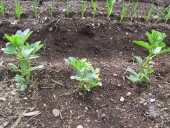It's really difficult when we aren't right there to see the damage. Is it possible to post some photos?
There are lots of times when I put loads of effort into solving one problem, only to discover it wasn't the problem, to begin with. I think that's why we are so interested to discover more about these grubs. Some grubs do cause damage, and yet, what you describe is different than what I've seen.
In permaculture, the trend is to observe first - there are so many things that could be causing these symptoms, grubs are just one of them, or they could be a coincidence or a symptom of a larger problem. It would be sad to waste time and effort fixing the grubs only to discover they were actually helping solve a bigger problem. Maybe the roots are suffocating due to poor drainage and the grubs were aerating the soil.
It's like cholesterol in humans. For years we thought cholesterol was the cause of heart disease when now we know it's something the body creates as an attempt to repair some damage. And yet popular opinion continues to believe that dietary cholesterol causes heart problems. Could it be these grubs are a symptom and local lore says they are the cause?
But like I said, I'm not there so it's difficult to see first hand. Photos will help, but in the meantime,
let's assume these bugs are causing the problem. What are the solutions?
Someone mentioned predatory insects are useful. They often are expensive to buy, but you mentioned you find them from time to time in the house. What you could do is to put them in a jar with some soil and the grubs and see if they kill the grubs. If so, then add them to the soil. It might not be the best idea to add them directly without an experiment in case they aren't the right grubs/insects but just look like them.
Drainage has a huge influence on grub activity. If your soil is too moist or compact, can you create a raised bed kind of thing for next season?
Speaking about season, one of the keys to avoiding bugs is to know their active seasons - March fly where I am, are most active in the rainy season - they are also attracted to vegetable material on the surface of the soil - so I don't use mulch in the rainy season. Sometimes the solution is as simple as that.
In case you want to go further into identifying the grubs, have a look at
the March Fly Solution thread. It shows how I grew some grubs into adults and sent photos to the bugguide people. They usually give me a positive identification within about 4 minutes - FOR FREE! I love those guys!
























 2
2

















 1
1











 1
1








 2
2







